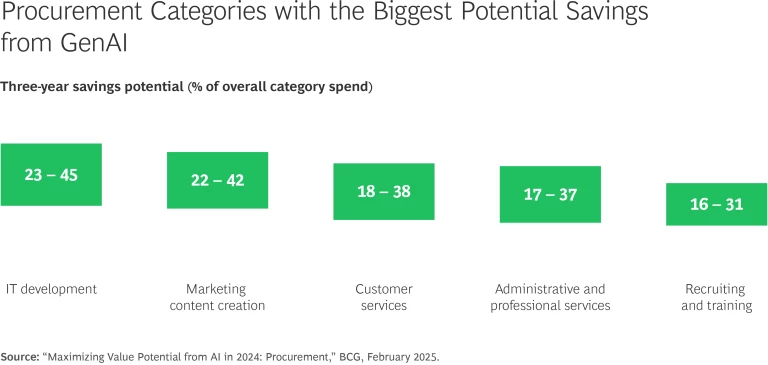Companies have made huge investments in AI, including generative AI (GenAI), and they’re seeing sizable gains in productivity and efficiency. Yet many organizations struggle to translate those improvements into concrete financial savings. Procurement is one area where AI can swiftly reduce costs. Some procurement processes are repeated over time and quantifiable, generating a volume of data that AI can sift through to rapidly improve performance and lower costs.
In our work with companies, procurement functions that use AI can reduce overall costs by roughly 15% to 45% (depending on the category) and eliminate up to 30% of the work for employees and teams. Those gains enable companies to reallocate procurement team capacity to more strategic, value-added tasks. Critically, AI also helps companies reduce risks along the supply chain, improving operational performance.
To capture this potential, chief procurement officers and other senior leaders need to apply four crucial steps, which we’ve seen a range of industries use successfully. Companies that seize the initiative today can give themselv es a first-mover advantage, moving past the buzz about AI and using the technology to generate bottom-line impact.
The Urgent Need to Cut Costs and Create Value in Procurement
Virtually all companies want to cut costs across the enterprise, but several trends are making AI adoption increasingly urgent for procurement teams.
Rising costs for goods and services, along with more price-sensitive customers, are adding pressure on company budgets and profit and loss statements.
- Growing Cost Pressures. Rising costs for goods and services, along with more price-sensitive customers, are adding pressure on company budgets and profit and loss statements. Meanwhile, large fluctuations in pricing can throw off financial plans.
- Competition for Capital. Leadership teams are facing competing demands for resources to invest in technology, fuel innovation, and growth or to undergo transformations to meet other needs (such as the energy transition).
- Operational Risks. Supply-chain risks because of geopolitical uncertainty, weather-related disruptions, and other factors are pushing procurement teams to make supply chains more transparent, agile, and resilient across all supplier tiers.
- Sustainability Compliance. Companies are facing new regulations and standards in areas like environmental sustainability, human rights, and other factors, which carry compliance requirements across the upstream supply chain.
- AI Adoption Among Sellers. Increasingly, early adopters among sellers are leveraging AI to improve negotiations, enhance communications, and streamline sales processes. To stay competitive, procurement teams need to implement the technology as well.
Boosting Performance with AI-Enabled Procurement
In our experience, AI-enabled procurement allows companies to dramatically improve their performance across several dimensions.
Because AI makes processes so much more efficient, companies can go beyond cost reductions on the goods and services they purchase to create recurring savings through leaner procurement teams.
Cost Savings. AI can aggregate all procurement information (including internal data, supplier information, and market pricing trends) to identify the biggest savings opportunities across suppliers and categories. It can also suggest concrete and actionable steps to reduce costs—for example, quantifying the power balance between buyers and individual suppliers so that the company can prioritize key opportunities and negotiate with more clout. Besides unlocking additional savings opportunities in categories and with suppliers, AI-enabled procurement can execute this type of analysis about 90% faster than manual data analysis, cutting costs significantly.
Increased Productivity. GenAI can also accelerate procurement processes, such as drafting personalized supplier letters and other forms of communication, all supported by up-to-date pricing data and other criteria. With one click, for example, buyers can adjust the language and style of an email requesting a price reduction––using language that is open and cooperative (in situations that favor the supplier) or, conversely, conveying a sense of urgency through a more demanding tone (when the buyer has more power). AI thereby frees buyers to spend more time on value-added tasks such as cultivating stronger relationships with sellers or prepping more effectively for negotiations.
Reduced Operational Risks. AI can reduce supplier risks along the entire supply chain. Instead of time-consuming, manual processes to collect and analyze a wide range of data (often limited to only the most strategic suppliers), companies can use AI to rapidly identify and evaluate risks along the entire supply chain and proactively mitigate them—including risks of a geopolitical, operational, financial, sustainability, and reputational nature.
Subscribe to our Operations E-Alert.
Leaner Teams. Because AI makes processes so much more efficient, companies can go beyond cost reductions on the goods and services they purchase to create recurring savings through leaner procurement teams. Such AI-enabled teams need fewer operational buyers and can instead shift the focus to strategic buyers that manage relationships and explore new market opportunities. Teams will also need new skills in areas like data engineering, prompt engineering, and compliance and ethics to ensure that companies have the right guardrails in place on how AI is used in procurement.
First-Mover Advantage. Although some sellers have started using AI and GenAI, most have not. Companies that proactively implement the technology in procurement can therefore give themselves a first-mover advantage––building critical skills and experience and staying ahead of the curve.
One Company’s AI Success Story
When a global manufacturer wanted to implement GenAI into procurement, it started out by conducting multiple workshops with the team to define a clear GenAI vision. This allowed the manufacturer to identify three lighthouse projects––use cases to start the journey––in the following areas:
- Knowledge Management. An AI-enabled tool gave teams faster access to internal knowledge, leading to greater quality and productivity gains of 50% to 75% on searches.
- Offer Analysis. A second tool helps buyers compare and summarize offers, reducing work time by about 50%.
- Tender Assistant. A third tool uses GenAI to create and review tender drafts, accelerating the process by about 50%.
By starting small but with a clear long-term vision, the company was able to build internal competence and team buy-in. Now it is positioned for greater progress in using AI to create value in procurement.
Four Central Steps for AI Transformation
To capture value in procurement through AI, companies need to focus on the following steps:
1. Conduct a digital maturity assessment.
First, establish a baseline of the company’s digital maturity. Although diving straight into AI implementation might be tempting, rushing ahead will invariably waste time and money without a clear understanding of the enterprise’s pain points. Consider all aspects of digital maturity in the assessment, including the existing tech infrastructure, the capabilities of IT and procurement teams, the degree to which the company’s current procurement processes are digitized, the degree of direct collaboration with suppliers, and the data architecture in place.
The maturity assessment also covers the company’s level of ambition in each of these areas, along with industrywide benchmarks. In that way, it highlights pain points in purchasing processes, along with other areas where the company should implement digital solutions and AI into procurement.
Although diving straight into AI implementation might be tempting, rushing ahead will invariably waste time and money without a clear understanding of the enterprise’s pain points.
2. Make the right buy-versus-build decisions about technology.
As with all technology, companies need to determine whether to implement off-the-shelf AI software or build a customized solution. The universe of off-the-shelf options is growing, with solution providers increasingly integrating AI and GenAI into their existing product suite. These options offer speed and well-designed user interfaces, and they generally don’t require strong in-house AI capabilities to launch and use. At the same time, they may not capture the full potential value for a procurement function.
Companies that have greater ambitions regarding AI are investing to build bespoke solutions and develop internal capabilities. These solutions can be more effective at meeting a company’s needs by increasing spend transparency, reducing costs, supporting complex negotiations with suppliers, analyzing and optimizing current contracts, and meeting environmental, social, and governance goals. Making the buy-versus-build determination requires looking at a range of factors. (See “Six Criteria for Making the Buy-Versus-Build Decision.”)
Six Criteria for Making the Buy-Versus-Build Decision
Performance: Can current features meet the company’s needs? Is the solution reliable and accurate?
Speed to Launch: How aggressive (and flexible) is the launch timeline?
Costs: What is the budget required to develop, deploy, and integrate the solution? What costs are associated with ongoing usage?
Existing Tech Ecosystem: Is the company working with an AI vendor to develop a solution for this use case? Will the solution operate on its own or need to interact with other systems? Does the company need to maintain a consistent user interface?
In-house Engineering: Does the company have in-house engineering capabilities and resources? How available is on-premise or cloud computing capacity?
3. Upskill the team.
AI doesn’t simply enable procurement functions to do the same work faster; it fundamentally changes the type of work that must be done. Success therefore entails a significant upskilling effort among people in companies.
BCG’s extensive experience helping companies integrate AI has revealed that, more than the technology itself, the individuals who work with AI are critical to the endeavor’s success. Of the total value that AI generates, just 10% comes from the algorithms themselves and 20% from the data and technology platforms. The remaining 70% comes from people’s motivation to adopt new ways of working, learn new skills, and change day-to-day behaviors. Leaders can create the right conditions for this evolution through a robust change management approach, clear communication, strong governance, and smart process design. Users should be centrally involved in the design and implementation phase.
Often the existing workforce can develop new capabilities, such as using AI for decision support, leveraging GenAI to reduce and streamline administrative processes, and incorporating new protocols for risk and compliance. In other areas, procurement teams will need entirely new skills, like data science and AI engineering. Most functions will need to hire specifically for these areas.
More than the technology itself, the individuals who work with AI are critical to the endeavor’s success.
4. Capture value from suppliers.
Last—and most important—procurement teams need to use these new AI capabilities to generate financial value from suppliers, through better preparation for negotiations, more accurate data analysis, and other factors.
In addition, teams can leverage the fact that suppliers are increasingly adopting GenAI internally in order to enhance both sales efficiency and productivity. As suppliers reduce costs, procurement teams should capture this value—from short-term price renegotiations to actively educating suppliers on GenAI adoption, exploring new supplier options, or even replacing certain suppliers altogether by using GenAI in-house.
Our analysis shows that companies can save roughly 15% to 45% across categories, mainly from a select group of product and service categories. (See the exhibit.) That said, to fully realize the benefits, it’s crucial to continue scaling interconnected solutions and thereby ensure that initial successes translate into broader, long-term transformation across procurement operations. To maximize value creation, solutions must be seamlessly embedded into purchasers’ workflows while delivering a “wow-like” first-use experience to drive continuous adoption. Additionally, upskilling users and ensuring strong leadership commitment are essential to sustaining momentum and enabling long-term success.

Companies that have implemented AI now need to take the next step and translate those investments into concrete financial value. Procurement is a key opportunity. By applying the four steps discussed here, procurement leaders can dramatically improve performance, reduce risks, and unlock the full value of AI.









